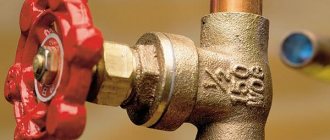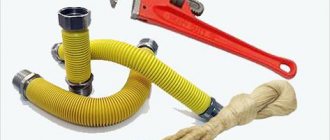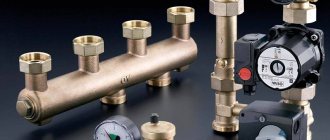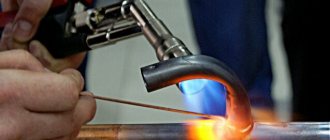Have you noticed how many different ways experienced craftsmen can offer to solve the same problem? The construction of a gas pipeline is no exception. Thus, the connection of gas pipes by professional gas workers is carried out using different materials and techniques. The craftsmen's arsenal includes carving and welding, soldering and flanges. They actively use techniques that have been proven for decades and those that have recently emerged.
Knowing the basic methods, understanding the tools and modern materials, it is easier to track the correctness of the work and monitor the actions of invited specialists.
In this article we have described the main options for fastening gas pipes and methods for sealing joints. After reading it, you will understand the types of pipes, the characteristics of materials, and the technologies for working with them. We paid special attention to methods for checking connections that have already been made, since the safety of operation of household gas equipment depends on their correctness.
Types of pipe connections
There are several main ways to connect gas pipes, or rather:
- Welding - carried out exclusively by specialists who have permission to work with a welding machine. Each employee must have a personal identification card.
- Threaded or fitting - also involves welding lightweight pipes, with the sockets sealed using hemp fiber. The whole process of work is very much reminiscent of connecting sewer pipes. It is worth noting that the fiber is pre-impregnated with a solution of linseed oil or drying oil. You can also use couplings that can have either long or short threads.
- Flange is one of the most common connection methods, as it has a fairly lightweight assembly design. However, according to experts, it is less reliable than welding.
All of the connection methods described above are used by professional craftsmen using specialized equipment.
In order to independently connect gas pipes in a house or apartment, you need to prepare the following tools and materials:
- gas adjustable wrench;
- tow and grease;
- hoses or pipe connections;
- if necessary, a connector with threads on both sides.
If you turned off the gas supply and purged the pipes, as recommended earlier, then the next step is to cut off unnecessary parts of the gas pipes. To do this, you can use a grinder, and if you don’t have one, then a hacksaw is quite suitable, but in this case the process will be lengthy and more complicated.
After you have removed the unnecessary part of the gas pipe, you need to carefully weld or solder one end of it.
If you need to connect one end of the pipe to a gas hose, you will need to cut a thread on the sawn part. To do this, there is a special nozzle, putting it on, you will need to scroll several times.
Next, tow is wound onto the thread made, which is soaked with lubricant and a connection is made to the hose. All this work is carried out using a gas adjustable wrench. If you plan to install a new pipe, you can use a special connecting adapter. This element has a ready-made thread on both sides and a nut that is screwed onto the main and new pipes.
This method can be used in apartments, you just need to make sure there are no leaks. To do this, you need to open the gas supply, then apply a soap solution to all pipe joints.
If you have never done such work yourself before, then it is best to entrust this matter to professionals.
Gas stove connection diagram
Schematically, connecting the stove to gas is as follows: a gas riser passes through the kitchen room, from which a branch pipe with a tap at the end is connected, which is connected to the stove. This piece is also called a drop or tap.
In older houses, a petal type faucet is installed on the slopes. When reconnecting, it is recommended to replace it with a ball one. It takes up less space and is more convenient to use
A rubber-fabric hose is screwed into the faucet, through which gas is supplied. For old houses, it is common to place the slab on a metal pipe. This method is inappropriate to use, because in this case the location of the device will be stationary.
In remote areas of the private sector, where there is no access to a main gas pipeline, gas is used in cylinders. Only a gas service specialist is allowed to connect to such equipment.
Sealing of household air ducts
Ventilation in apartments and country houses is carried out using thin-walled elements. Often, air ducts are made of rectangular cross-section or from corrugated pipe. Threading on such connections is not possible. Therefore, sealing ventilation joints is carried out in other ways:
- through flanges,
- applying a bandage,
- using the socket method by inserting one air duct into another.
A flange connection is most often used for non-circular ducts. Sealing is carried out using gaskets made of soft material, for example, porous rubber. The shape of the gasket must match the cross-section of the air duct.
With other methods, the voids formed after joining the air ducts are filled with mastics whose temperature characteristics correspond to the operating conditions of the air line. Sometimes the joint of the air ducts is wrapped with self-adhesive tape.
Bandage clamps used for joining round air ducts
Types of dielectric inserts for gas
The dielectric for a gas hose, according to the product range of elements for gas distribution devices, is divided into two standard categories. These are insulating taps, couplings, barrels or bends, as well as standard bushings. The choice of a specific type depends on the installation conditions and the characteristics of a particular system.
Insulating couplings
Insulating coupling made of dielectric material
Couplings are divided into three categories, which differ from each other mainly by their threaded diameter; its value can be 15, 20 or 25 mm. Separation according to this criterion makes it possible to install inserts in any pipelines, since the Russian gas pipeline system does not use diameters smaller than 1/2 and larger than 1/4. Subtypes of inserts, so-called barrels, can have external threads on both elements or internal and external threads on each.
Dielectric bushings
Such inserts are liners that prevent the passage of electric current. They are placed between gas pipes and wiring, the diameter of such elements ranges from 8-27 mm, both sides are threaded from the inside. Bushings are not inferior to couplings in terms of resistance and strength; parts can withstand pressure up to 493 atmospheres.
Application of FUM
FUM tapes and threads are used for sealing threaded connections of hot water supply (DHW), heating systems (CO) and cold water supply (CW). They are also used when connecting gas appliances to the gas pipeline.
Fluoroplastic is a plastic and strong material with a melting point above 400 degrees, resistant to oxygen and aggressive liquids. The thread and tape fill the unevenness of the thread and ensure sealing of the joint. FUM sealing tapes are produced with a width of 10-16 mm and a thickness of 0.08-0.12 mm, FUM threads with a diameter of 0.4-1.5 mm. With temperature changes and vibration, the FUMs are deformed and the threaded connection leaks.
The thickness of the tape winding depends on the diameter of the pipe and the thickness of the tape. For pipes with a diameter of up to 20 mm, 2-3 layers of tape with a thickness of 0.12 or 1-1.5 layers of thread are wound. For pipes with a diameter of up to 40 mm, 5-6 layers or 2-3 layers of thread are wound. For pipes with a diameter of over 40 mm, 8 or more layers of tape or 5 or more layers of thread are wound. For main pipelines, it is preferable to use tapes with silicone mastics.
If the thread is covered with rust, the winding thickness is doubled. Before winding the tape, the threaded connection is cleaned with an iron brush and blown with compressed air. The tape and thread are wound onto the pipe or fitting thread under tension with a force of 0.5-1 kg clockwise. To seal the threaded connections of gas appliances, they are wound counterclockwise.
Wind with a cone from the edge of the joint. If, after cleaning the rust, holes and damage are noticeable on the threads, use a different sealant. FUM is used to seal undamaged threaded connections.
Do not use FUM to seal heating pipes. Temperature changes will damage the FUM, the connection will leak, and water or steam leakage from the heating system will cause burns.
Is FUM tape used for sealing steam and water heating pipes? No, experienced plumbers seal such joints only with flax (tow) and sealant.
What is a dielectric coupling?
This is a kind of insulator that does not allow potential to pass from the ground (also called “stray currents”) to the body of the gas appliance. This protects the control electronics from failure.
The effect is especially pronounced on so-called “smart devices” (where there are control boards), for example modern gas boilers, less so on stoves and gas water heaters.
Winding tape onto pipe threads
This operation is always performed using an external thread. If repairs are made by replacing the fitting, the pipe threads must be thoroughly cleaned of dirt and rust, degreased using acetone or white spirit, and dried in air for about 10 - 12 minutes. How to use a pipe burner to ensure its effectiveness:
- the seal must be wound onto the thread from its rear end;
- the FUM tape is applied in the direction of its descent, that is, its end should be located in the direction of screwing on the fitting;
- winding is carried out with tension, ensuring a tight fit of the pipe thread profile; it is better to allow the tape to break than to perform loose winding;
If there are no such notches, you need to do them yourself.
FUM tape for pipes is a modern and most commonly used means for sealing joints in pipelines for various purposes. FUM cord products that have appeared in recent years do not provide any special advantages either in application technology or in efficiency.
To understand how to use FUM tape for gas pipes, you need to take into account the characteristics of the material and apply it in the appropriate way.
Watch the video
Alternative materials – linen tow
Various seals are used, which include bast fibers in the form of strands and various sealants.
One of the first sealing materials to find widespread use in pipeline installation is tow. This is still the name given to flax fibers in the form of strands wound on the external thread of a pipe.
In this case, it is important to wind it carefully in turns, filling out the full cutting profile. For more reliable sealing, the winding of tow is covered with additional materials, from thickly rubbed paint to specially developed sealants
The advantages of sealing joints with plumbing tow are as follows:
- the ability to adjust the interface at its location - it is possible to turn the fitting in the opposite direction at an angle of up to 45 degrees without losing its insulating properties;
- sufficiently reliable tightness and ability to absorb moisture;
- the joint is resistant to mechanical stress;
- facilitated dismantling of the joint.
Disadvantages include the tendency to decompose as a result of putrefactive processes, since the material is an organic product.
Video
There is no clear answer to the question of choosing a method for sealing a threaded connection. The undoubted advantage of using tape is the connection of cantilever elements, such as taps or mixers; coupling connections of pipelines are best made with plumbing tow.
Sealants
Not only increases the impermeability of the connecting area, but also significantly increases its ability to withstand mechanical loads
Which is very important in pipeline systems due to constant vibration influences and water hammer
The sealant hardens upon contact with air or the mating surfaces of the threaded joint, acting as an adhesive and turning the assembly into a monolithic part.
The most common way of classification is by color and there are two main positions for this division:
- blue – represents medium strength sealants. Can significantly reduce the intensity of the thread loosening process. In practice, even the slightest weakening of a joint will require prolonged exposure to serious loads of an alternating nature. But when using blue sealants, it is still possible to turn the thread, although with great difficulty;
- When using red sealants, such an operation without heating does not seem realistic. This gel simply glues the structure together. For pipelines it is used in places with strong vibrations (from pumping equipment) and when water hammer is possible.
Conclusion
FUM tape for gas pipes is one of the main ways to seal joints during pipeline installation. The methods outlined here for how to use a paddle for gas pipes take into account all the main features of the material, but do not exclude the performer’s creative approach to this important operation. It is necessary to understand that the gas pipeline is a source of increased danger.
Video
When is it better to use polyethylene pipes?
If you plan to lay a gas pipeline in the ground, then in this case you cannot do without polyethylene pipes. Steel pipes in this case are not the best option, since, when laid in the ground, they are vulnerable to corrosive processes.
In theory, both cross-linked and regular polyethylene can be used to make gas lines. However, cross-linked polyethylene is hardly used as there is no benefit from it being more durable and heat resistant. But its price is higher when compared with ordinary low-density polyethylene.
In a store, identifying polyethylene pipes that can be used for gas supply is quite simple. A yellow line is drawn along their entire length.
It is worth noting that polyethylene compression fittings are not used on gas connections. Their mechanical strength is limited, and it is not worth completely excluding the possibility that no external influences will be exerted on the gas pipe.
Sleeve connections, for which either rubber seals or glue are used, are also not suitable. Most often, this method is used when it is necessary to connect PVC pipes intended for sewage. They are not suitable for gas because they do not guarantee complete tightness.
All that remains is to use three types of fittings:
- brass, which provide both tightness and mechanical strength;
- fittings for welding, which are connected with a soldering iron at low temperatures (it is recommended to set the temperature to 240 degrees Celsius);
- electric welded, on which spirals have already been applied, intended for melting contact surfaces. They are expensive but can guarantee a high quality connection.
Fighting the leak
Fixing a heating system leak using a sealant is a chemical fight against leaks.
The specified German sealant proved to be excellent in solving this dilemma. The following tools are also used:
- Resins with two components based on epoxy.
- Adhesive silicone compounds.
- Heat-resistant compounds based on rubber.
Their algorithm:
- The damaged area is degreased, dried, and covered with a thin layer of sealant.
- Next, it is wrapped with serpyanka. Serpyanka reinforces the sealed layer.
- The serpyanka is already covered with sealant. The action is repeated.
If a silicone product is used, then you do not need to use abrasives to grind the damaged area. And this type of sealant adheres better to a smooth surface.
Stray current - where does it come from in the gas pipeline
Such currents appear in the ground due to an accidental breakdown of a household or industrial power line. The source of stray voltage can be either a ground loop or an electrified railway or tram line. This current enters the gas pipeline due to the difference between the resistivity of the earth and the metal parts of the gas supply line. In fact, all electricity discharged into the ground does not go into the ground (it has too much resistance), but into uninsulated cables or metal structures. And since most of the main and household gas pipelines are made of metal, the appearance of stray current in the system is only a matter of time.
Stray current protection
The main pipe can become a source of stray voltage in a household gas pipeline. To protect the gas supply pipeline from corrosion, the line is loaded with an electrical potential of insignificant strength, which suppresses the natural process of electrochemical splitting in the structural material. And if a breakdown of the dielectric insert for gas occurs in the common insulator separating the main line from the household branch, then the useful protective potential will turn into an unwanted stray current.
In addition, stray voltage may appear in the internal gas supply line due to poor grounding of the circulation pump or other electrical appliances in contact with the heating system wiring or the home gas pipeline branch. Another reason for the appearance of such currents may be an error when installing a boiler, water heater or gas stove connected to the electrical network. As you can see, stray current is not a myth, but a real problem. And the metal structure that falls under its influence turns into a serious threat to the safety of all residents of the house connected to the gas pipeline.
Welding of gas pipelines
Welding of gas pipes under pressure is carried out by highly qualified welders who have certificates for such work.
Manual arc welding and flash contact welding do not provide reliable corrosion resistance of the joint area
, only the pressure welding method eliminates these disadvantages.
Welding in a special welding installation occurs in this way: - the pipe is fed along the roller channels until it stops at the stopper of the immovable clamp and the pipe is clamped there. The supply of the second pipe is carried out until it stops at the first pipe, then the movable clamp is clamped; — a special mechanism regulates the difference between the edges and pre-pressure is created at the joint through a movable mechanism; — by longitudinal and transverse movement of the heating unit supports, the inductor is first adjusted to the junction and then closed; - turn on the induction heating source, and when the welding temperature is reached, the temporary relay will turn off the heating source; — the time allocated for welding one joint is no more than one minute; — a command is given for the upsetting of the welded pipes; after upsetting, the clamping devices are unclenched, the movable clamp returns to its initial position and the installation is ready to accept a new pipe.
This welding method is used in the gas industry to join ferrous pipes and pipes with an internal anti-corrosion coating.
Portable stoves with the ability to connect to different gas cylinders
The M series stoves can run on all liquid fuels, making them extremely convenient for any situation, not just as universal camping equipment. Tiles in this series will work not only on gas. Kerosene, gasoline, diesel fuel - any available fuel. Liquid fuel allows you not to be left without heat and hot food even in the most extreme conditions. The presence of a gas generator (a special tube in which liquid fuel turns into a gaseous state) turns the tiles of this series into the most popular product.
The H series involves the use of a gas outlet hose; in addition, some models are equipped with fuel heating, which increases the power of the stove itself and the range of its use.
Small stoves of the S series with Screw Type valve are used as portable stoves, lightweight, compact, optimal for saving space in a backpack. They are used with PF-FG-230 and PF-FG-450 cylinders; they just need to be screwed all the way onto the gas container. The stove rests directly on the gas cartridge itself, so you won’t be able to cook a large volume; the total load on the cartridge should not exceed 5 kg.
In addition, tabletop stoves are offered with the ability to connect to household cylinders. These tiles have a completely civilized appearance and can be used both on hikes and in the kitchen. They usually have 1-2 burners, they weigh little, are conveniently packaged, and piezo ignition eliminates another minor concern.
“Pathfinder” PoweR PF-GST-M01, a single-burner stove with the ability to connect to a large cylinder and a small collet, has an analogue with expanded capabilities, a real masterpiece from MaximuM PF-GST-DM01, which is equally comfortable to use on a hike and stationary in the countryside . Neat appearance, two burners. You can install small collet containers (one for each burner) and power the tiles from ordinary volumetric valve cylinders. For the second option, an adapter designed specifically for this purpose is suitable for both plates.
Requirements for gas sealants
To completely eliminate gas leakage at the connecting points of the gas pipeline system, it is necessary that the winding meet the following requirements:
- resistance to vibrations of varying intensity;
- resistance to sudden changes in temperature and internal pressure;
- protection of the connection from the formation of corrosive deposits;
- ease of installation and dismantling in case of repairs;
- durability and long period of use.
All sealing materials must be tested by specialists for strength and certified for use in gas supply systems.
Methods for checking the tightness of connections
The tightness of the gas pipeline is checked in sections. In a situation with apartment buildings, a segment is selected from the point of fuel entry into the building to the taps of household equipment.
Plugs are placed at the ends of the section. The pressure in the pipes exceeds the standard values by 25%. A drop in pressure is a reason to check connections.
It is forbidden to check gas leaks using open fire: matches, candles. Lighters and piezo lighters are not suitable for this purpose. Fuel accumulated near the connection may explode
The integrity of joints, branches and equipment connection points is checked in two ways:
- Using a gas leak indicator.
- By applying a soap solution or emulsion.
In the first case, a digital, sound or color signal from the device will notify you of the danger. In the second, you need to monitor the appearance of bubbles. Their presence indicates a violation of the integrity of the connection.
Types and conditions of sealing
It is necessary to insulate joints when laying pipes for different types of pipelines. The only exception is welded joints, but this is their disadvantage - they are permanent. And joints using threads make it easy to replace a damaged area or insert a new harness.
Therefore, sealing is necessary for threaded pipe connections:
- hot and cold water supply,
- gas pipelines,
- heating.
In practice, threads are used in small-diameter pipelines - in internal wiring of houses and apartments, country cottages and when laying networks to detached buildings with low water and gas consumption. For large diameter water supply and heating pipes, flange connections and welding are used.
Ventilation lines, as a rule, have a large cross-section and are made of thin-walled sheets or corrugated pipes. Therefore, threaded connections are not used in them, but sealing the joints is still necessary.
When choosing a method for sealing pipe connections, it is necessary to take into account their properties and the conditions in which they will function:
- External temperature of the medium and internal temperature of the medium in the pipeline. Some types of sealants lose their properties at elevated temperatures or frost.
- Line pressure. Liquid insulators can be squeezed out of the connection under high pressure.
- Pipe diameter.
- The final strength of the connection. This is the force required to disassemble an insulated joint in case of repair or reassembly.
- Environmental Safety. When laying pipelines for drinking water, do not use substances that can release toxic compounds.
Most of the means and substances used for sealing, according to these parameters, fall within the range required for joining household pipelines. But a particularly careful choice is necessary when sealing gas pipe joints. Loss of tightness in water lines is noticeable from the very beginning by traces of leaks at the joints. Gas leaks are not visible and may remain undetected for a long time.
Conclusions and useful video on the topic
The video shows three methods of sealing standard threaded connections:
Having gained an understanding of the materials from which gas pipeline pipes are made, types of connections and sealing methods, it becomes clear that it is better to entrust all work to professionals. An experienced master will be able to choose the optimal joining method, a suitable sealant, and correctly check the integrity of the connection.
If you have experience in sealing joints, you are aware of new products in the sealing compounds market, write. Our site is visited by both beginners and those who have something to share. Exchange experiences, knowledge, ask questions. The form below allows you to accompany your comment with photographs, diagrams, and sketches.
Features of installing an exhaust pipe for gas appliances
When installing gas heating appliances, as well as oil radiators, it is necessary to pay due attention to the issue of competent organization of the removal of combustion products from the premises. And this is correct, because, in addition to creating a safe environment for people, they increase the efficiency of the heating devices themselves, contributing to their more productive and economical operation
To determine the diameter of the gas outlet channel, it is necessary to take into account:
- Amount of combustion products.
- Power of heating devices.
- Temperature difference between outside air and combustion products.
- The height of the chimney pipe.
Installation of exhaust pipes for gas appliances, in accordance with the rules, is carried out next to internal walls and near partitions made of non-combustible materials. If necessary, it is also permitted to install them in external walls, also from non-combustible materials. In this case, in order to avoid the appearance of condensation when removing combustion products, the walls on the outside are insulated. If there is no wall in the room that is suitable for placing exhaust pipes in it, you need to use a root or attachment pipe for a gas appliance.
It is necessary to ensure maximum open access to the pipes.
Installation of gas appliances that do not have a connection to the chimney duct is carried out exclusively in a place where at least 5 m3 of free space will be allocated for each burner. A small water heater that is not equipped with exhaust gas combustion products must be allocated at least 6 m3. A gas water heater for a shower room or bathroom must have an exhaust hood for gas combustion products and a free space of at least 10 m3.
If the room where the gas stove is being installed does not have the required volume, then a ventilation outlet must be made above it. Since gas appliances use air from the room for combustion, it must be freely available. For this purpose, a small gap is left under the floor door (the area of the gap is calculated from the calculation: for every 1000 kcal/h of gas appliance power, at least 10 cm2 is required).
All heating devices, geysers, etc. are equipped with a fuse to shut off the gas if the fire goes out.
Installation of gas heating devices must always be carried out with a connection to the chimney in all cases except one: if it is a heater with a closed combustion chamber. Then the exhaust of combustion products and the air supply to the burner are separated from the room. A chimney with a cross-sectional area of 200-220 cm2 can be connected to a pair of gas appliances on one floor with a gas flow rate of 8 m3/hour. The height distance between the inlets into the chimney must be at least 30 cm. To connect four gas appliances from one apartment with a gas flow rate of 12 m3/h, on one floor you need a chimney with a cross-sectional area of at least 300 cm2. Connecting gas appliances to the same chimney on different floors is unacceptable.
The chimneys of gas appliances are located above the roof in the same way as conventional chimneys. When, during the reconstruction of a house, it is impossible to use the old chimney to remove gas combustion products from the stove, a new chimney is made from pipes that are connected to the rear facade of the house. These pipes are made of galvanized steel sheets, and, unlike pipes for removing combustion products of liquid and solid fuels, they are connected by joints that are directed in the opposite direction from the movement of gases.
During repairs or reconstruction, when the tightness of gas pipes may be compromised, it is necessary to check their integrity upon completion of the work. For this purpose, air is introduced into the pipes at a pressure that is twice the pressure that is necessary in them when gas passes through (approximately 500 mm of water column).
Before checking, you need to close the taps. If within five minutes the pressure in the pipes drops by more than 20 mm of water. Art., then you need to look for damage in the pipe (the suspected places of damage need to be moistened with soapy water). The gas pipeline for liquid gas is checked for leaks in the same way under a pressure of 1200 mm water. Art.
Threaded connections are applied to pipes, as well as connecting and branch fittings. But the simplicity and reliability of connecting any pipelines using threading still does not ensure its complete impermeability. Therefore, a mandatory addition is to seal the pipes at all points of threaded joints. Only this combination allows you to create a reliable connection.
Rules for installing ventilation equipment
Optimal performance of the device depends on the following factors and installation rules:
- The size of the ventilation device must correspond to the dimensions of the hob. Then all the hot, contaminated air flow will be completely sucked in by the hood and discharged outside, or cleaned through a filter and fed back into the kitchen. The standard dimensions of the device range from 60 to 90 cm.
- Properly installed hood above the stove. The distance from the appliance to the stove should not contradict fire safety standards and depends on the type of stove. The required distance from the stove to the hood is always indicated in the technical data sheet of the device.
- Connecting the device to the network.
- Installation of air exhaust pipes, if required by the design of the exhaust hood.
It is better to entrust the installation of ventilation equipment to professionals. But for those who are confident in their abilities, it will not be difficult to hang the device with their own hands.
Installing a hood with a circulation type of operation is not difficult. First you need to measure its height and mark it with control points. Then you should drill holes in the wall for the fasteners. Next, the device is mounted to the wall or to wall cabinets using self-tapping screws and special hooks included in the kit.
Hoods of another type of air purification are installed in the same way as circulation hoods. Only here you need to attach the air duct pipe to the umbrella body. The pipe can be plastic or foil.
Upon completion of installation of the equipment, it is necessary to carry out a control check of its operation (mainly for the second type of model). If the hood does not function or is too noisy, you should once again check all the connections between the device and the ventilation pipes and their integrity.
Natural sealants
Jute and tow are used in conjunction with silicone sanitary sealants. The thread is cleaned of dirt and rust, coated with sealant, the sealant is twisted into a thread and wound clockwise flush with the thread crest. When winding, the seal is pulled with a force of 0.5-1 kg.
After winding, carefully coat with sealant and assemble the connection. Within 5-8 minutes, until the polymerization process is completed, it is necessary to check and, if necessary, tighten the connection further. Tightening the nut after the sealant has polymerized will cause leakage.
Stores sell ready-made plumbing thread for sealing pipes, made from flax. It doesn't need to be twisted. Before you buy a thread, read on the packaging what it is made of and whether it contains silicone or acrylic sealants. If it is a fluoroplastic thread, it is not advisable to use it on damaged threaded connections; if it is a vegetable thread without sealant, then purchase sanitary sealant separately.
Owners of apartments and houses ask: “Which thread is best for pipes?”, meaning the brand. To which a professional plumber will answer: “Better is the thread that was skillfully wound.”
If there is more or less thread than required, or it is not wound along the threads, the connection will leak. Do not wind it “with reserve”, wind it as much as necessary and do not forget about the sealant.
Metal-plastic for gas
Metal-plastic pipes can also be used for gas supply. The inside of pipes of this type is made of polyethylene, which is already familiar to us.
Due to the fact that metal-plastic pipes are supplied in coils, it becomes possible to lay a fairly long gas pipeline without using a large number of connections.
If the pipes still need to be connected, then only press fittings must be used. With their help, you can ensure the tightness of the connection, which will retain its properties for a long time. However, to make such a connection you will need a special device.
Types of sealing tapes
This material is produced in the form of winding on a reel up to 10 meters long. Successfully used for winding onto pipe threads in pressure systems, including water, gas and heating systems.
Its purpose in connections is a deformable filler that acts as a thread lubricant, helping to increase tightness. This seal is available in 3 types:
- type 1 – for use in pipeline systems for transporting aggressive liquids, used using purified petroleum jelly;
- type 2 – for pumping strong oxidizing agents, which prohibits the use of additional sealant in the form of oils;
- type 3 – used for transporting relatively pure liquids and gases; the use of lubricants is excluded.
Sealing threads with thread.
For those who are too lazy to twist flax into strands and then smear it with paste, they came up with a sealing thread. The thread can be made from different materials:
- Polyamide - designed for a pressure of 16 atmospheres on water and 8 atmospheres on gas, has an upper temperature threshold of 130° C.
- Fluoroplastic - has characteristics identical to FUM tape, but usually costs more.
Manufacturers lubricate the thread with a special lubricant, the composition of which they do not disclose. In my opinion, fluoroplastic thread is better in quality and I recommend it to you, despite the fact that it is more expensive than polyamide thread. If you want to learn how to wind thread correctly, watch the following video:
—
CONDITION 1
| RESULTS. â |
RESULTS RESULTS RESULTS. RESULTS ÑÐ±Ñ Ð¸ нанеÑÐµÐ½Ð¸Ñ Ð±Ð¸ÑÑмнÑÑ Ñлоев ÑовмеÑÐµÐ½Ñ Ð¸ Ð ²ÑполнÑÑÑÑÑ Ð½Ð° одной ÑÑÑÑÐ °Ð½Ð¾Ð²ÐºÐµ, ÑазмеÑаемой в конÑе поÑоÑной лиР½Ð¸Ð¸. â
| RESULTS. â |
RESULTS RESULTS ASSURANCE RESULTS. â
| RESPONSIBILITY, RESULTS °ÑÑка газо. â |
RESULTS, RESULTS ÑопиÑанной клеем. RESULTS RESULTS ¿Ð»Ð°ÑÑиковÑÑ Ð¾Ð± олоÑкÑ-бандаж. ROOM давлениÑ. â
RESULTS ¸Ð·Ð¾Ð»ÑÑионнÑм маÑеÑиалом. RESULTS. â
| RESULTS. â |
RESULTS s ROOM CONTENTS, CONDITIONS линии. â
| RESULTS. â |
ROOM CONTENTS , , , , , , , , ¾Ð»Ð¾Ñки; RESULTS OPTIONS . ROOM ROOM . â
RESPONSIBILITY ss, ss RESULTS CONCLUSION: 1) ROLLING UP, LOCKING ´Ð½Ð°Ð· наÑеннÑÑ Ðº гÑммиÑованиÑ; 2) RESEARCH, CONDITION; 3) RESULTS ROOM из ÑаолиÑа; 4) RESULTS з ÑекÑÑоѰолиÑа и дÑ. RESULTS, RESEARCHES ÑÑ ÑÑанение вÑÐµÑ ÑÑÐ¸Ñ Ð²ÐµÑеÑÑв. â
RESULTS RESULTS RESULTS. RESULTS ÑÐ±Ñ Ð¸ нанеÑÐµÐ½Ð¸Ñ Ð±Ð¸ÑÑмнÑÑ Ñлоев ÑовмеÑÐµÐ½Ñ Ð¸ Ð ²ÑполнÑÑÑÑÑ Ð½Ð° одной ÑÑÑÑÐ °Ð½Ð¾Ð²ÐºÐµ, ÑазмеÑаемой в конÑе поÑоÑной лиР½Ð¸Ð¸. â
| RESULTS. â |
→ RESULTS RESULTS RESEARCH Ñой, п ÑопиÑанной ÑпокÑиднÑм клеем. RESULTS RUR 50 RUR °Ñи и вÑÑе. RESULTS оÑиÑаÑÑ. â











